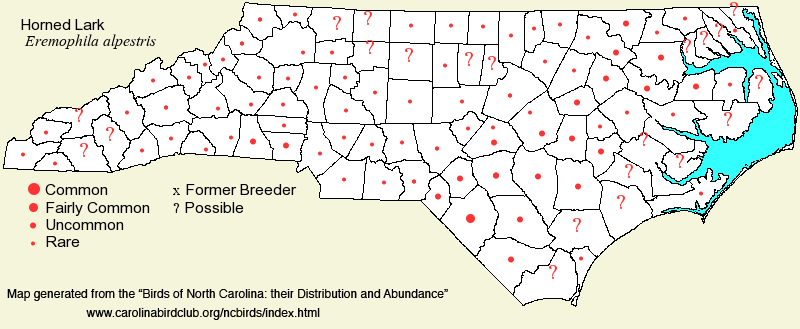 |  |
|
Horned Lark - Eremophila alpestris Sole representative of ALAUDIDAE in NC | Search Common: Search Scientific: |
|
|
|||||||
| General Comments | The Horned Lark has one of the widest breeding ranges of any passerine on the continent; it is also the only native species of lark that nests in North America. It avoids breeding in the extreme Southeast, as it is a cold-hardy species. It also nests in as barren (devoid of plants) habitats as practically any songbird, and this is especially true in the East. Though it nests sparingly across most of North Carolina, it is mostly local or scarce, except in some areas of the Coastal Plain, where not uncommon in some areas. Numbers are increased somewhat in winter, though it is still generally uncommon. At all seasons, Horned Larks are found in short grass areas -- nearly bare croplands (prior to planting or growth of crops), airports, sandy barrens, etc. In fall and winter, they also occur in plowed fields, at times in sizable flocks. | ||||||
| Breeding Status | Breeder | ||||||
| NC BRC List | Definitive | ||||||
| State Status | |||||||
| U.S. Status | |||||||
| State Rank | S4B,S4N | ||||||
| Global Rank | G5 | ||||||
| Coastal Plain | Permanent resident, with the population increased in winter. In summer, uncommon to fairly common, at least locally, in the western and central sections, but locally rare to absent in Tidewater and in most coastal counties. In winter, locally common in the northern third of the province, southeast to the Lake Phelps area; status similar to summer elsewhere (i.e., most of the migrants into the region seem to occur only in the northern regions), except the occasional bird is found in winter toward the coast. There is a localized year-round population at North River Farms in central Carteret. Peak counts: 1,000, Occoneechee Neck (Northampton), winter 1976-1977. A count of 150, including many juveniles, at North River Farms (Carteret), 21 Jul 2002, is amazing. | ||||||
| Piedmont | Permanent resident, with migratory movements; declining, with loss of suitable habitat. Rare and local summer resident, seemingly absent in some counties, such as Durham and Orange. In winter, rare to locally uncommon over the region; migrants arrive in Oct or Nov, and depart by Mar. Peak counts: 130, Raleigh, 2 Feb 1978. | ||||||
| Mountains | Permanent resident, with migratory movements; scarce and not well known. Very rare to rare, and local breeder, such as on grassy balds. Some arrive in winter, at plowed fields in extensive farmland in valleys, but rare to uncommon, and local. Peak counts: 250, Hooper Lane (Henderson), 21 Jan 1996. | ||||||
| Finding Tips |
Your best bet is to drive back roads, and make numerous stops, at extensive farmland, in Coastal Plain counties such as Robeson or Edgecombe, in Apr, May, or early Jun; listen for the tinkling song, especially where the soil is sandy (i.e., where cotton will be planted). Otherwise, in winter, look in northern Coastal Plain counties such as Halifax where there are very extensive plowed fields, and scan and listen for calls. Hooper Lane north of Hendersonville has also been reliable in winter. The birds are easier to find in the breeding season, as they are not as local at that season. *** | ||||||
| Attribution | LeGrand[2023-03-26], LeGrand[2013-02-28], LeGrand[2012-09-15] | ||||||
| NC Map Map depicts all counties with a report (transient or resident) for the species. | Click on county for list of all known species. |
| NC Breeding Season Map Map depicts assumed breeding season abundance for the species. |  |